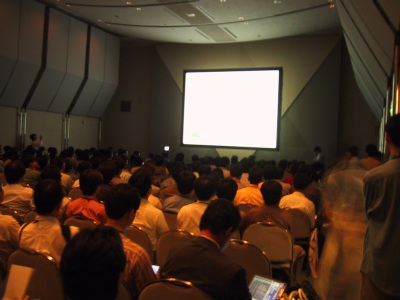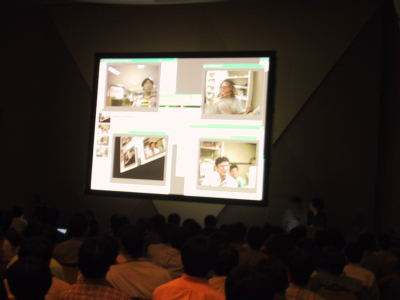NetBSD: BSD BoF at NetWorld+Interop Tokyo summary
|
On June 7th, 2001, a BSD BoF was held as one of the night sessions at NetWorld+Interop Tokyo. What follows is a short summary of the discussion, based on a netbsd-advocacy mailing list post by Jun-ichiro itojun Hagino. Many of the URLs referenced are in Japanese. |

|
BSD BoF at NetWorld+Interop Tokyo
- About the event itself
- Mr. Mano of root-hq.com, on wireless internet devices
- Shigeru Yamamoto of IIJ, on SEIL-T1
- Jun Ebihara on Hitachi GR2k router
- Mr. Etoh on gcc mod for buffer overrun attack detection/protection
- Mr. Shiroyama on MacOS X
- Ms. Kurata from WindRiver
- Mr. Imai on XCAST
- Mr. Takeoka on "Shikigami" avator
- Mr. Kahei Suzuki of ASCII, on meeting room usage
- Random announcements
BSD BoF at NetWorld+Interop Tokyo
About the event itself (top)


The event was subtitled "BSD, Life with Revolution Evolution DEVOlution" (the title was taken from a song title by a Japanese cult rock band). We have done this kind of event a couple of times.
NetWorld+Interop provided us with the meeting room as a courtesy. We would like to thank them here.
300+ people attended in person (there were fewer chairs than the number of people - so some of them had to sit on the floor). 50-100 people attended over irc (volunteers typed the discussions to a couple of irc channels), and 828 clients watched the discussion over RealVideo transmission.
To summarize the event in 4 words, it was A LOT OF FUN.
http://www.jp.FreeBSD.org/event/N+I2001_BOF/
http://www.jp.FreeBSD.org/event/N+I2001_BOF/program.html
(pictures appears by courtesy of Ms Shoko Araki)
Mr. Mano of root-hq.com, on wireless internet devices (top)
This company, ROOT Inc., manufactures an embedded NetBSD device, with 802.11 and ethernet device built in. The specification of the device is as follows:
Hitachi SH3 CPU, 167MHz, ROM: 32+1M, RAM: 32M 10Base-T, RS232C, RS422, RTC, PCMCIA slot for a 802.11 card NetBSD 1.4.2, zebra ripd, apache
He also started a company very recently, called "mobile internet solutions". The company aims to deliver internet reachability everywhere by the wireless technologies, and promote a (non-PC) ubiquitous internet environment.
http://www.root-hq.com/pressrelease/01.6.5.html
The answer to "why NetBSD?" was "pure luck". Someone recommended NetBSD by chance (if the recommendation was different, he could have picked Linux or other *BSD). Luckily for us NetBSDers, he is happy with his choice.
He also announced a scholarship possibility, for those presenting their ideas for the usage of root-hq.com wireless devices.
ToDo: IPv6, mobile-ipv4/6, OSPF, PDA/cellphone-like handset device (rather than an infrastructure device).
Shigeru Yamamoto of IIJ, on SEIL-T1 (top)
SEIL-T1 is a small router device for small offices and such. IIJ is actually an ISP, and it's rare for an ISP to manufacture routers. IIJ has router-integrated services, like router maintenance outsourcing and such. Also, it should be noted that IIJ is highly active in the IPv6 arena. This is the first ISP to launch official IPv6 connectivity service in Japan.
Specs: SH3, NetBSD 1.4 + KAME (next version of the firmware will be 1.5.1), T1 and 10Base-T. 32M RAM, 4M flash memory. web and telnet config interface (next version of the firmware comes with Secure Shell logins, and all config interfaces are IPv6 accessible). IPv6, IPsec including IKE, traffic shaping, monitoring (MRTG-ish stat tool inside).
Good things about using NetBSD: the availability of source code, multi architecture (and the cleanness required to be such), UNIX programming environment for user interface portion.
Troubles: compiler bugs (-O2 sometimes emits non-working code), alignment pickiness of SH3, debugging environment (DDB sometimes does not work right).
The development team pays a very large amount of effort on user interface. Web interface is for novice admins, and telnet/ssh interface is for advanced admins. Even for telnet/ssh interface, SEIL-T1 does not use normal /bin/sh or /bin/csh - it has home-brew command line user interface (with cisco-ish ondemand help). It is critical to present a consistent user interface to the admins.
An attendee suggested to use Hitachi-made commercial compiler, which should be more stable than gcc.
Jun Ebihara on Hitachi GR2k router (top)
With a hidden command he demonstrated that it runs BSD/OS 3.1 :)
Mr. Etoh on gcc mod for buffer overrun attack detection/protection (top)
http://www.trl.ibm.com/projects/security/ssp/
With his mods, binaries compiled with gcc -stack-protection become safer against buffer overrun attacks. The technique includes reordering of auto variables, checks against signature variable after function call, and some other items. The modification is made against gcc intermediate code, so it should be easier to be architecture independent.
His notebook PC runs FreeBSD compiled with the modified gcc. It requires modification to gcc (of course), 6-line changes to the kernel, and 16-line changes to shared library. The compilation was very simple - just a matter of "make world".
He has tested his mod on i386, sparc and powerpc. He solicited for more testers. Also, he suggested to compile FreeBSD packages (precompiled third-party application binary) with safer compiler like this, to protect many users.
Mr. Shiroyama on MacOS X (top)
He presented the internals of MacOS X, and demonstrated its GUI. To quote Steve Jobs, "MacOS X will be the most popular UNIX distribution". From the market statistics it seems true. Also, MacOS X/Darwin seems to include the KAME IPv6 stack (which is one of the contributions from Japan to the BSD community), but its not enabled yet.
Apple is taking a very aggressive approach in switching their operating system from a legacy non-protected one to a modern one (compare it with Microsoft, which is having very hard time switching from Win95/98 to Win2K/XP). This may be because this is very critical for Apple to transition (if they fail to switch, the company may vanish).
The audience laughed very hard when Mr. Shiroyama demonstrated "port scan" menu on the network management dialog :)
Ms. Kurata from WindRiver (top)
She clarified the goals/plans of WindRiver on BSD, after the BSDi merger.
Mr. Imai on XCAST (top)
XCAST is short for "explicit multicast", an experimental multicast-ish protocol discussed in IETF. It is designed for multicast groups with small number of people/group (like a mahjong net game with 4 participants each). With normal internet multicast, the multicast routing table management on routers would be cumbersome, There are patches against NetBSD 1.5, FreeBSD (2.2.8+KAME, 3.5+KAME and 4.3), and he called for more geeks to play with it.
He presented this over IPv6 video chat application (of course with XCAST), from UC Irvine!
Mr. Takeoka on "Shikigami" avator (top)
Shikigami is an user interaction avator for the "shikigami" PDA user interface suite (or, to describe it literally, cute girl AI on X11 screen). Backend AI/controller is implemented with scheme (a popular dialect of Lisp), and the graphical frontend is implemented with Xlib.
Functionalities include (still growing): wink, clock/alarm, fork external command, URL passing to netscape, biff (checks # of queued email over pop3). ToDos include: real AI, scheduler, voice i/f.
He solicited for more illustrators (to draw cute "skins") and voice actressess.
Mr. Kahei Suzuki of ASCII, on meeting room usage (top)
ASCII is a major computer publisher in Japan, and is known to be an advocator of BSDs and UNIXes. He announced that the company can let people use ASCII meeting rooms for free software activities (like this BoF). ASCII is located in Shibuya-ku, near Shinjuku and Hatsudai station (central Tokyo). Detailed descriptions were given, like no commercial activity (selling T-shirts for non profit purpose would be okay), the equipment in the meeting rooms, network availability, that one ASCII employee must attend, how guards would audit attendees, and such. Contact kahei-s@ascii.co.jp.
Random announcements (top)
June 9, 2001 - Open Source Convention at Nagoya U
http://www.nu-net.or.jp/tosc/2001/
June 25-30, 2001 - Usenix/Freenix 2001
June 30, 2001 - Japan NetBSD Users' Group meeting at ASCII meeting room
Back to NetBSD events page (contact us) Generated from %NetBSD: interop-tokyo-2001.xml,v 1.5 2005/12/25 22:35:40 jschauma Exp %
Copyright © 1994-2006 The NetBSD Foundation, Inc. ALL RIGHTS RESERVED.
NetBSD® is a registered trademark of The NetBSD Foundation, Inc.
![[NetBSD flag]](/images/NetBSD-flag.png)